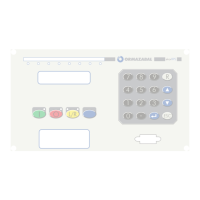IG-150-EN version 04; 03/10/16
61
General instructions
ekor.rps
Protection functions. Description and settings
The settings (6 tables) are:
Setting Min Max Step Notes
Module enable
NO
YES
K module constant
0 10 0.01
Angle enable
NO
YES
Angle
0 359 1
The settings are located in the console in the “2
nd
harmonic restraint” and “manual closing protection blocking” screens.
Table 4.9. Settings
4.6. Directionality of the phase and neutral overcurrent protections
Depending on model, the described protection functions
can be directional.
In that case, each of the functions (timed, low instantaneous,
high instantaneous) has an additional setting, “torque
control”, if it is FOWARD or REVERSE, it indicates that
the function must act as directional (in one direction
or in the other one) and if it is set as NO it must act as
NONDIRECTIONAL.
For the neutral directional there are 4 directional types: The
angular, the watimetric, the I*cos(j) and the I*sen(j).
Watimetric directional and the cosen type directional are
practically equal, with the only exception that one is set to
W and the other one to A.
Even when the torque control set at YES
(FOWARD or REVERSE), the directionality
can be blocked (make it operate as non-
directional) by PROCOME command or
by digital or logic input (if it has been
programmed in the “Locking (I)” screen in
the “directional” position.
The settings corresponding to the directionality criteria
are on the screen “overcurrent protection screen (3)”. The
possibilities are related next and afterwards the functions
operation is described.
Phase direction criteria. It is applied in the phase directional
function (67). Next are the possibilities: “Quadrature” and
“sequences”.
Phase angle (degrees). Programmable from 0 to 360°. It is
applied in the phase directional function (67) and in the
neutral directional function (67N) in case the S- neutral
direction criterion has been chosen.
Neutral polarization. This setting is only for models that have
the possibility to polarize the neutral direction by current.
In this case, the possibilities are V (polarization by voltage
only), I (polarization by current only) or V+I (polarization by
both parameters).
Neutral directional type. It can be programmed as “angular
criteria”, “Icos phi”, “Isen phi” or “watimetric”.
Neutral direction criteria. It is applied in the neutral directional
function when it is polarized by voltage. The possibilities
are: S
0
(zero voltage polarization), S- (polarization by
negative voltage sequence), or S
0
+ S- (polarization by both
parameters).
If several polarization criteria combinations are used, the
fault will be decided to be forwards if some of the criteria
show it is forwards.
Neutral angle (degrees). Programmable from 0 to 360°. It is
applied in the neutral directional function (67N) in case the
S
0
neutral direction criterion has been chosen.
Minimum active power. It is used for watimetric directional.
Setting range from 0 to 2000 W in steps of 1 W.
P=V
r
*I
r
*cos(j-jc) j=Ánguloentre V
r
eI
r
.
If the power is higher than this value in negative it is
considered to be forward fault. If it is higher than this value
in positive value it is backwards fault.
Minimum current. It is used for I*cos(j) and I*sen(j) directional.
Setting range from 0.1 to 200 A in steps of 0.01 A.
I
minimum
=I
r
*cos(j-jc) j=angle between V
r
andI
r
.
If the I minimum is higher than this value in negative it is
considered to be forward fault. If it is higher than this value
in positive value it is backwards fault.
Polarization voltage. It is the minimum value of the
polarization voltage, below which it is considered that the
direction is not known with certainty.
V
r
minimum threshold. In order to allow the pick up of the
neutral directional unit, a V
r
minimum threshold must be
exceeded.

